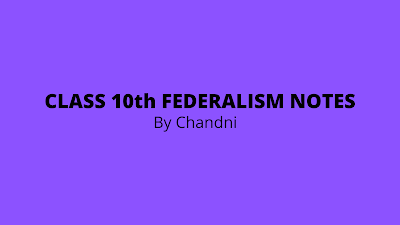Class 10 Federalism Notes
Topics covered in
this chapter
· Meaning of Federalism
· Union list, State list, Concurrent list, and Residuary
list
· Union Territory
· Main features of Federalism
· Types of Federalism
· Is India a Federal country?
· How is Federalism Practiced?
· Decentralization in India and Local Government
Class 10 Federalism Notes
Meaning of Federalism
Federalism is a system of
government in which the power is divided between central authorities and
various constituent unit of a country.
Union List
The union list includes
matter of national importance upon which the central government would take the decision.
It includes subject like Defence of the country, foreign affairs, banking,
currency and communication.
Past: - 97% subject included
in it and Present: - 99%
State List
The state list includes
matter of state level and local level importance on which the decisions would
be taken by the state governments. It includes subject like Police, trade,
commerce, agriculture and irrigation.
Past: - 66% subject included
in it and Present: - 61%
Concurrent List
The concurrent list includes the
subject of both the central as well as state government. It includes matter
such as education, forest, marriage and trade unions.
Past: - 47% subject included
in it and Present: - 52%
Residuary List
Those subject which is not
included in union, states and concurrent list.
UNION TERRITORY
1.
Andaman and
Nicobar island
2.
Chandigarh
3.
Dadra and Nagar
Haveli
4.
The capital city
of Delhi
5.
Lakshadweep
6.
Pondicherry
7.
Jammu and Kashmir
8.
Ladhakh
Main Features of Federalism
2.
Each level of
government has its own jurisdiction in matter of legislation, taxation and
administration even though they govern the same citizen.
3.
The fundamental
provision of the constitution cannot be changed by only one level of
government.
4.
The supreme has
been given power to settle disputes between federal governments.
5.
Source of revenue
between different levels is specified by the constitution.
6.
Thus, the
objectives of the constitution are unity and diversity.
Types of Federalism
Coming Together
Ø Many independent state come together to form a bigger
unit.
Ø All states have equal powers
Ø State and Central government are equally powerful
Ø For Example : - U.S.A, Australia, Switzerland
Holding Together
Ø A large country decides to divide power between state
and central governments.
Ø States have unequal power
Ø Central government is more powerful
Ø For Example: - India, Belgium, Spain.
1.
Three levels of
government...Central, state and local.
2.
Jurisdiction of
each level of government is specified in country.
3.
India is ‘HOLDING
TOGETHER FEDERATION’.
4.
In disputes
between state and central government then Supreme Court makes a decision.
5.
All states of
India do not have equal powers.
How is Federalism Practiced?
Linguistic States
Ø In 1947, the boundaries of several old state of India
were change in order to create new states such as on the basis of language and
on the basis of culture.
Language Policy
1.
Our constitution
has not made any language the national language of India.
2.
Hindi was
identical as the official language.
3.
Beside Hindi, there
is 21 other language recognized as Scheduled language by the constitution.
4.
State has own
official language too.
5.
English along
with Hindi used for official purposes.
Hope it helps!


0 Comments